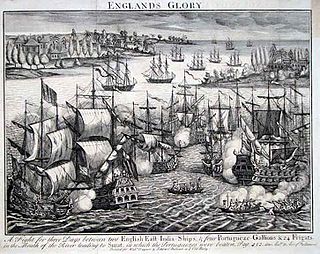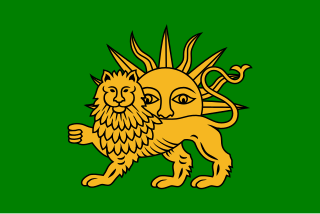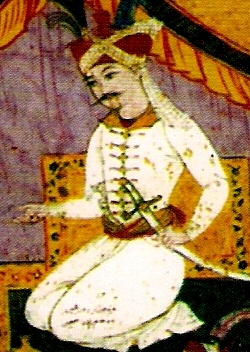
The 1570s decade ran from January 1, 1570, to December 31, 1579.

1612 (MDCXII) was a leap year starting on Sunday of the Gregorian calendar and a leap year starting on Wednesday of the Julian calendar, the 1612th year of the Common Era (CE) and Anno Domini (AD) designations, the 612th year of the 2nd millennium, the 12th year of the 17th century, and the 3rd year of the 1610s decade. As of the start of 1612, the Gregorian calendar was 10 days ahead of the Julian calendar, which remained in localized use until 1923.

Year 1577 (MDLXXVII) was a common year starting on Tuesday of the Julian calendar.

The Safavid dynasty was one of Iran's most significant ruling dynasties reigning from 1501 to 1736. Their rule is often considered the beginning of modern Iranian history, as well as one of the gunpowder empires. The Safavid Shāh Ismā'īl I established the Twelver denomination of Shīʿa Islam as the official religion of the Persian Empire, marking one of the most important turning points in the history of Islam. The Safavid dynasty had its origin in the Safavid order of Sufism, which was established in the city of Ardabil in the Iranian Azerbaijan region. It was an Iranian dynasty of Kurdish origin, but during their rule they intermarried with Turkoman, Georgian, Circassian, and Pontic Greek dignitaries, nevertheless, for practical purposes, they were Turkish-speaking and Turkified. From their base in Ardabil, the Safavids established control over parts of Greater Iran and reasserted the Iranian identity of the region, thus becoming the first native dynasty since the Sasanian Empire to establish a national state officially known as Iran.

Abbas I, commonly known as Abbas the Great, was the fifth Safavid shah of Iran from 1588 to 1629. The third son of Shah Mohammad Khodabanda, he is generally considered one of the most important rulers in Iranian history and the greatest ruler of the Safavid dynasty.

Tahmasp I was the second shah of Safavid Iran from 1524 until his death in 1576. He was the eldest son of Shah Ismail I and his principal consort, Tajlu Khanum.

Ismail I was the founder and first shah of Safavid Iran, ruling from 1501 until his death in 1524. His reign is often considered the beginning of modern Iranian history, as well as one of the gunpowder empires. The rule of Ismail I is one of the most vital in the history of Iran. Before his accession in 1501, Iran, since its Islamic conquest eight-and-a-half centuries earlier, had not existed as a unified country under native Iranian rule. Although many Iranian dynasties rose to power amidst this whole period, it was only under the Buyids that a vast part of Iran properly returned to Iranian rule (945–1055).

Ismail II was the third shah of Safavid Iran from 1576 to 1577. He was the second son of Tahmasp I with his principal consort, Sultanum Begum. On the orders of Tahmasp, Ismail spent twenty years imprisoned in Qahqaheh Castle; whether for his recurrent conflicts with the realm's influential vassals, or for his growing popularity with the Qizilbash tribes, resulting in Tahmasp becoming wary of his son's influence.

Mohammad Khodabanda, was the fourth Safavid shah of Iran from 1578 until his overthrow in 1587 by his son Abbas I. Khodabanda had succeeded his brother, Ismail II. Khodabanda was the son of Shah Tahmasp I by a Turcoman mother, Sultanum Begum Mawsillu, and grandson of Ismail I, founder of the Safavid dynasty.

The Shamlu tribe, also known as the Shamli tribe, was one of the seven original and the most powerful Qizilbash tribes of Turcoman origin in Iran.

Ibrahim Mirza, Solṭān Ebrāhīm Mīrzā, in full Abu'l Fat'h Sultan Ibrahim Mirza was a Persian prince of the Safavid dynasty, who was a favourite of his uncle and father-in-law Shah Tahmasp I, but who was executed by Tahmasp's successor, the Shah Ismail II. Ibrahim is now mainly remembered as a patron of the arts, especially the Persian miniature. Although most of his library and art collection was apparently destroyed by his wife after his murder, surviving works commissioned by him include the manuscript of the Haft Awrang of the poet Jami which is now in the Freer Gallery of Art in Washington D.C.

The Guarded Domains of Iran, commonly called Safavid Iran, Safavid Persia or the Safavid Empire, was one of the largest and longest-lasting Iranian empires. It was ruled from 1501 to 1736 by the Safavid dynasty. It is often considered the beginning of modern Iranian history, as well as one of the gunpowder empires. The Safavid Shāh Ismā'īl I established the Twelver denomination of Shīʿa Islam as the official religion of the empire, marking one of the most important turning points in the history of Islam.
Jesse, also known as 'Isa Khan Gorji was a Georgian prince of the royal house of Kakheti, whose career flourished in the service of the Safavid dynasty of Iran and included several years as a governor of Shaki in what is today Azerbaijan.

Pari Khan Khanum was a Safavid princess, daughter of the second Safavid Shah, Tahmasp I and his Circassian consort, Sultan-Agha Khanum. From an early age, she was well-loved by her father and was allowed to partake in the court activities, gradually becoming an influential figure who attracted the attentions of the prominent leaders of the militant Qizilbash tribes.

Haydar Mirza Safavi was a Safavid prince who declared himself as the king (shah) of Iran on 15 May 1576, the day after his father Tahmasp I had died. He was, however, killed that same day by the Qizilbash tribes that favoured his brother Ismail Mirza Safavi as the successor of their father. His mother was Sultanzadeh Khanum, a Georgian lady.
Suleiman Mirza was a Safavid prince. The son of king Tahmasp I by his Kumyk wife Sultan-Agha Khanum, he functioned several years as an official, serving as the governor (hakem) of Shiraz and Mashhad. His full sister was Pari Khan Khanum, and his Kumyk uncle Shamkhal Sultan – both extremely pivotal figures in Safavid affairs during the latter half of the 16th century.

Mirza Salman Jaberi Isfahani was a prominent Persian statesman in Safavid Iran, who served as the grand vizier of Ismail II and Mohammad Khodabanda.
Hasan Beg Rumlu was a 16th-century Safavid historian and military officer. A cavalryman of the qurchi corps, he is principally known for his chronicle of Safavid history; the Aḥsān al-tavārikh.
Bahram Mirza Safavi was a Safavid prince, governor and military commander in 16th-century Iran. He was the youngest son of Shah Ismail I, the founder of the Safavid dynasty.
The Tahmasp I's campaigns in Kartli and Kakheti was a series of campaigns of the Safavid Iran under the leadership of Shah Tahmasp I against the Georgian Kingdoms of Kartli and Kakheti.



















